November 15, 2013
Air Date: November 15, 2013
FULL SHOW
SEGMENTS
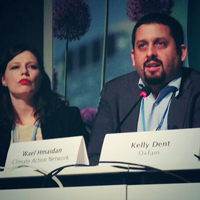
Hunger Strike for Climate Action
View the page for this story
Typhoon Haiyan kills thousands and underscores the importance of action from this year's UN Framework Convention on Climate Change meeting in Warsaw, Poland (COP 19). In an emotional speech, the Philippines delegate, Naderev “Yeb” Sano, announced that he would fast until meaningful action was taken at COP19 to slow global warming. Climate Action Network director Wael Hmaidan says he and many others at the meeting and around the world are fasting too. (08:55)
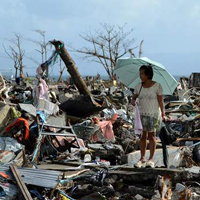
Typhoon Haiyan
View the page for this story
The 195 mph typhoon that devastated much of the Philippines set records as one of the strongest storms ever to make landfall. Kevin Trenberth from the National Center for Atmospheric Research says that scientists expect more such large powerful storms as climate change continues to warm the world’s oceans and cause sea levels to rise. (05:05)

Coal Loses Ballot Test
/ Ashley AhearnView the page for this story
County council elections turn on local issues, but the recent ballot in Washington State's Whatcom County drew big money and national interest. As Ashley Ahearn of public media's EarthFix reports,these councillors must approve any permit for a huge coal export facility, and those elected are considered by many to be opponents of such a coal terminal. (05:10)
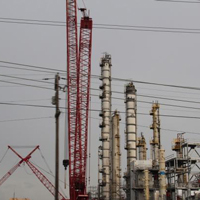
Fracking Boosts Plastic Production
View the page for this story
The fracking boom has led to renaissance for the chemical industry, particularly for plastics makers in Lousisiana, where the plants are major employers. In this report from the Gulf Coast, the Allegheny Front's Reid Frazier found that the chemical boom is fueling plenty of jobs in Louisiana, but they can be dangerous as well as lucrative. (08:00)

Beyond the Headlines
View the page for this story
In our weekly look beyond the headlines, Peter Dykstra of the daily Climate and Environmental Health News tells host Steve Curwood about a Florida real estate scam, the new “green” tea party, and perhaps the greatest scientific hoax of all time. (05:15)
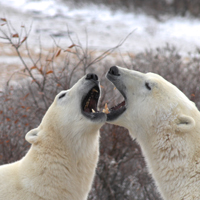
Polar Bear Attacks on the Rise
View the page for this story
Churchill, Manitoba is the polar bear capital of the world, but as polar bear expert Andrew Derocher tells host Steve Curwood, melting ice due to climate change is creating increased conflict between bears and the town’s human population. (07:00)
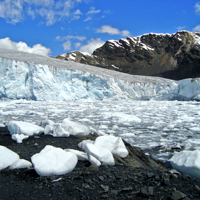
Climate Change Tourism in Peru
View the page for this story
Pastoruri Glacier in the Andes was once a destination for outdoor enthusiasts and skiers. Today the glacier has melted so much people are no longer allowed to walk there. But Reuters reporter Mitra Taj tells host Steve Curwood that Peru has come up with another way to make money from the glacier; climate change tourism. (04:10)

ICEBERGS!
View the page for this story
Icebergs are monumental and awe-inspiring and also potentially dangerous. Writer mark Seth Lender came close to the mighty mountains of ice and found them also beautiful and guarding hidden secrets. (03:50)
Show Credits and Funders
Show Transcript
Host: Steve Curwood
Guests: Wael Hmaidan, Kevin Trenberth, Andrew Derocher, Mitra Taj, Peter Dykstra
Reporters: Ashley Ahearn, Reid Frazier, Mark Seth Lender
[THEME]
CURWOOD: From Public Radio International, this is Living on Earth.
[THEME]
CURWOOD: I’m Steve Curwood. The latest UN climate summit kicks off in Poland, overshadowed by the devastation of supertyphoon Haiyan in the Philippines.
SANO: What my country is going through as a result of this extreme climate event is madness, the climate crisis is madness. Mr. President, we can stop this madness right here in Warsaw.
CURWOOD: The Filipino delegate vows to fast until there's meaningful action on climate change. Also how the hotter planet is making storms like Haiyan worse.
TRENBERTH: The environment in which these storms are occurring is changed because of climate change. The sea temperatures are higher and the storm surge because of the higher sea level is also greater than it otherwise would be.
CURWOOD: We'll have that and more this week on Living on Earth. Stick around.
[NEWSBREAK MUSIC: Boards Of Canada “Zoetrope” from “In A Beautiful Place Out In The Country” (Warp Records 2000)]
ANNOUNCER: Funding for Living on Earth comes from Stonyfield Farm, makers of organic yogurt, smoothies and more.
Hunger Strike for Climate Action
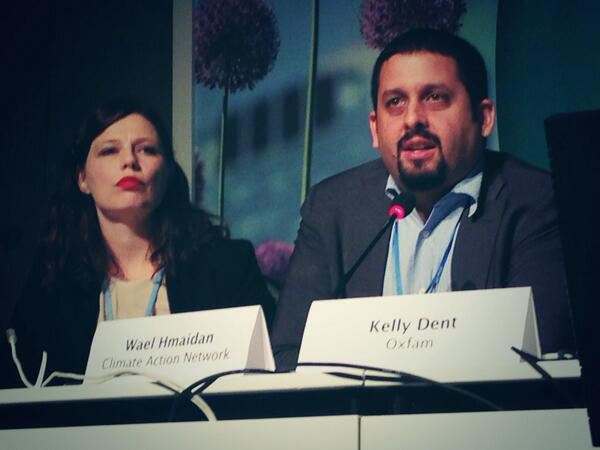
Wael Hmaidan, director of the Climate Action Network (photo: Climate Action Network)
CURWOOD: From the Jennifer and Ted Stanley Studios in Boston, this is Living on Earth. I’m Steve Curwood. Typhoon Haiyan was one the most powerful and destructive storms ever recorded, with sustained winds of 195 mph and gusts up to 230. And in terms of human impact, it may well be the worst. It scythed a trail of destruction across the Philippines, and on to Vietnam and China leaving thousands dead, and whole towns flattened.
The supertyphoon struck just before this year’s UN Climate summit began in Warsaw, Poland, and it underscored the increased violence of storms in a warmer world, and the need for urgent action. As the Conference of the climate convention parties got underway, there were many expressions of sympathy for the Philippines and gratitude from the Philippines delegate himself, Naderev Yeb Sano.
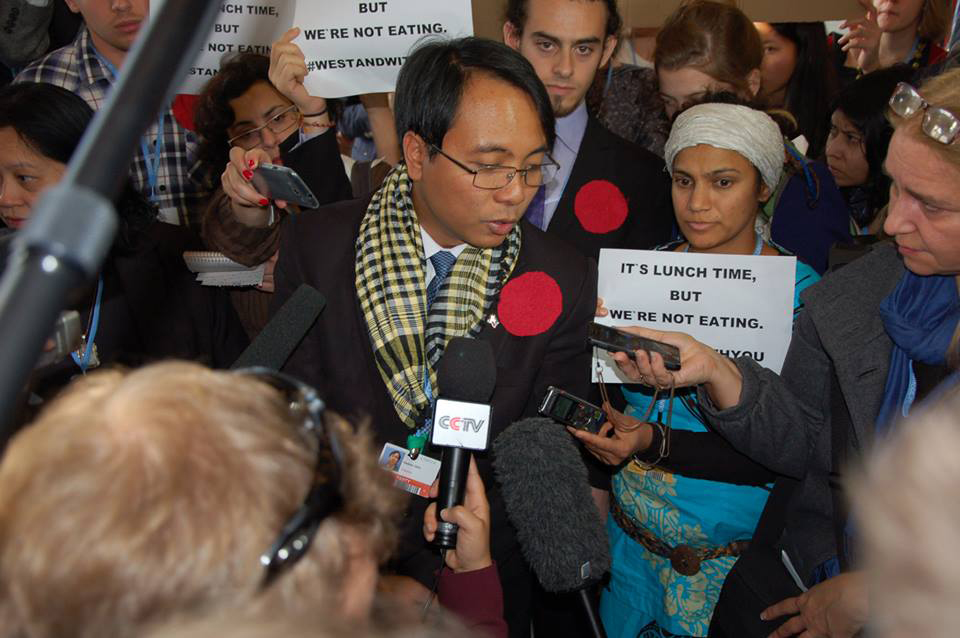
Yeb Saño speaking with reporters about his hunger strike at the climate change conference in Warsaw (photo: Climate Action Network)
SANO: It would be remiss of my delegation not to thank everyone who have expressed solidarity with my the Philippines in this difficult time.
CURWOOD: Yeb Sano is also the climate commissioner of the former American territory, and he gave a powerful and moving speech pointing out how little had been achieved by previous climate summits. He noted that promises made four years ago by rich nations to provide billions to help poor countries deal with climate change have yet to be kept, and now the disadvantaged are paying the price of inaction.
SANO: Mr President, in Doha we asked, if not us, then who? If not now, then when? If not here, then where? But here in Warsaw we may very well ask the same four trite questions. What my country is going through as a result of this extreme climate event is madness, the climate crisis is madness. Mr. President, we can stop this madness right here in Warsaw.
It is the 19th COP but we might as well stop counting because my country refuses to accept that a COP 30 or a COP 40 will be needed to solve climate change, because it seems that despite the significant gains we have had since the UNFCCC was born, 20 years hence we continue to fall short in fulfilling the ultimate objective of the convention.
Now we find ourselves in a situation where we have to ask ourselves can we ever attain the ultimate objective of the convention which is to prevent dangerous anthropogenic interference with the climate system. By failing to meet the objective of the convention we may have ratified our own doom.
CURWOOD: During his 17 minute speech Sano ignored frequent gongs telling him he was over his allotted three minutes, and struck a personal note. Supertyphoon Haiyan made landfall in his family's hometown, and he learned that though there was no food to be had, his brother was working, gathering up the dead bodies.
SANO: In solidarity with my countrymen who are struggling to find food back home, and with my brother who has not had food for the last three days, with all due respect, Mr. President, and I mean no disrespect for your kind hospitality, I will now commence a voluntary fasting for the climate. This means I will voluntary refrain from eating food during this COP until a meaningful outcome is in sight, until concrete pledges have been made to ensure mobilization of resources for the green climate fund. We cannot afford a 4th COP with an empty GCF.
CURWOOD: Yeb Sano added that climate summits have been called many things, including a farce, and an annual carbon intensive gathering of useless frequent flyers, and the Project To Save the Planet - which it could be.
SANO: We can fix this. We can stop this madness, right now, right here, in the middle of this football field and stop moving the goal posts. Now can Humanity rise to this occasion? Mr President, I still believe we can. Thank you, Mr. President, thank you.
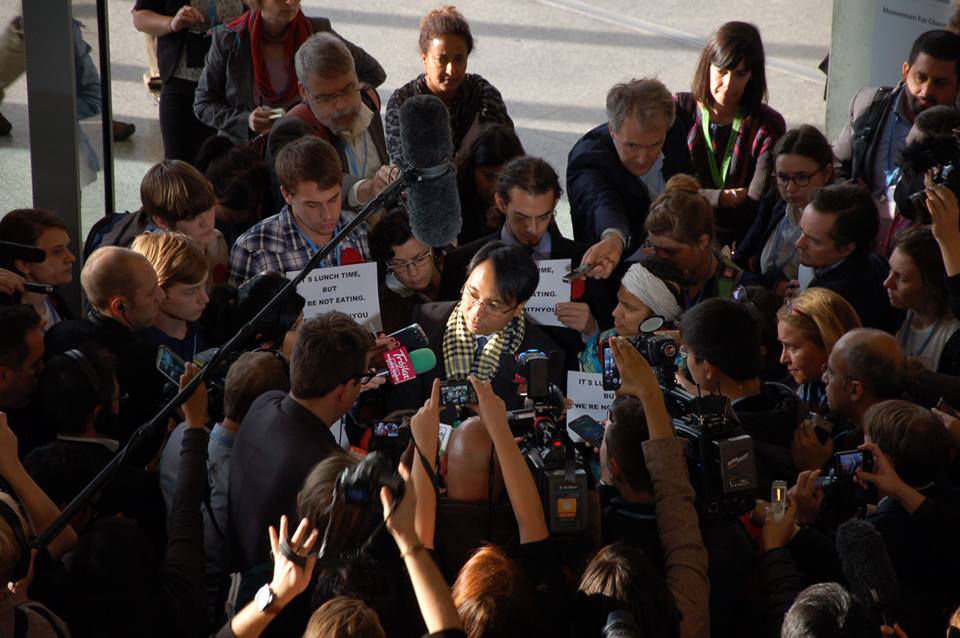
Yeb Saño speaks with the press (photo: Climate Action Network)
[APPLAUSE]
CURWOOD: Mr. Sano’s complete speech is at our website, LOE.org.
Climate justice advocates took Yeb Sano’s hunger strike as a call to action. In Warsaw and around the world, many are joining him, including Wael Hmaidan, the Executive Director of the Climate Action Network, which represents NGOs in 90 countries. He says Mr. Sano’s emotional appeal was no surprise.
HMAIDAN: We expected a very emotional speech, and it moved everybody there. What was not expected here is the reaction of the governments, so after Philippines’ speech we started hearing the other country’s groups talking and unfortuately we heard the same kind of rhetoric as if nothing has happened, as if the tragedy in the Philippines has no meaning.
CURWOOD: Now Mr. Sano announced that he was beginning a hunger strike until meaningful climate action was taken at the Conference of the Parties there in Warsaw, and you’ve decided to join him. Why?
HMAIDAN: Well, because we’re at this particular time of history. We really need to do something different than what we’re doing. We usually come here, try to negotiate, try to engage in climate policy text, trying to move commas, trying to move words, but the problem is not here, the problem is the political will. To solve climate change, it has to happen at the capitals first. We need to create new political will, and to do that we need to show that we’re serious. We need to take both actions.
It’s really unbelievable, and it’s really madness, as Sano says it, when countries just a day after Sano’s speech, a couple of days after the tragedy in the Philippines, they started reducing their climate ambitions, such as Australia actually repealing its climate legislation and cancelling funds that are earmarked for renewable energy. It’s unbelievable. And then you have Canada afterwards actually standing up and congratulating Australia for this move. This is insane. This is an insult to the Philippine people. This is actually telling the Philippine people that, “Yeah we’re fine with what’s happening...and expect more.” They’re sending them a death note.
CURWOOD: So how many folks have joined this hunger strike that you know about?
HMAIDAN: Well, you have students in the US, we have faith communities from around the world, you have NGOs, even some of the party delegates are contemplating joining this hunger strike. It’s not easy because we’re here working all day in negotiations, running around, we wake up at 6, return after 1 a.m. We sleep 3, 4 hours every night, but still people are going on hunger strikes. So there are now in the hundreds, I would say. It’s hard to count because initiatives are coming from around the world. We’re trying to connect people together, but it’s not easy.
CURWOOD: So tell me, how are you doing physically?
HMAIDAN: I’m feeling energized. I have to say I’m a bit surprised. I didn’t expect it to be that easy, and I think it’s because -- two reasons: one, it’s actually from the heart so I’m not feeling any stress, and, of course, the fact that we are so busy during the day trying to talk to the delegates, trying to coordinate civil society, the time flies, and I have to say, I’m feeling very fine, very energized and very motivated and very determined.
CURWOOD: What are your demands? What are the demands of the hunger strikers?
HMAIDAN: There isn’t one specific demand, again because it’s not coordinated in any way, and saying “This is what we all want.” For us, we want political movement. We want to see progress in the negotiations. We want to see respect to the vulnerable people like the people of the Philippines, the islands, Africa and all very poor developing countries. We know that it’s not going to be solved here in the COP, the climate problem. We know it’s a long term process, but we need to see some seriousness in it.
The numbers that the countries put on the table to reduce their greenhouse gas emissions that’s responsible for climate change are really pathetic. By 2050, we need to completely be free from fossil fuels: oil, coal, natural gas...if we want to save the species and human civilization from climate change impact. This not only requires cooperation not only of civil society, it needs to become a general public demand. It has to become a top priority of the general public. So the church, the youth, the development movement, all kinds of movers that are involved in health, human rights, development, poverty, they need to also understand that if we lose the climate fight, all other fights are lost.
CURWOOD: Wael Hmaidan is the Executive Director of the Climate Action Network. Thank you so much.
HMAIDAN: Thank you.
Related links:
- Listen to Yeb Sano's 11/11/13 speech to COP19
- Watch the video of Yeb San's speech from the International Institute on Sustainable Development
- More about the Climate Action Network (CAN)
Typhoon Haiyan
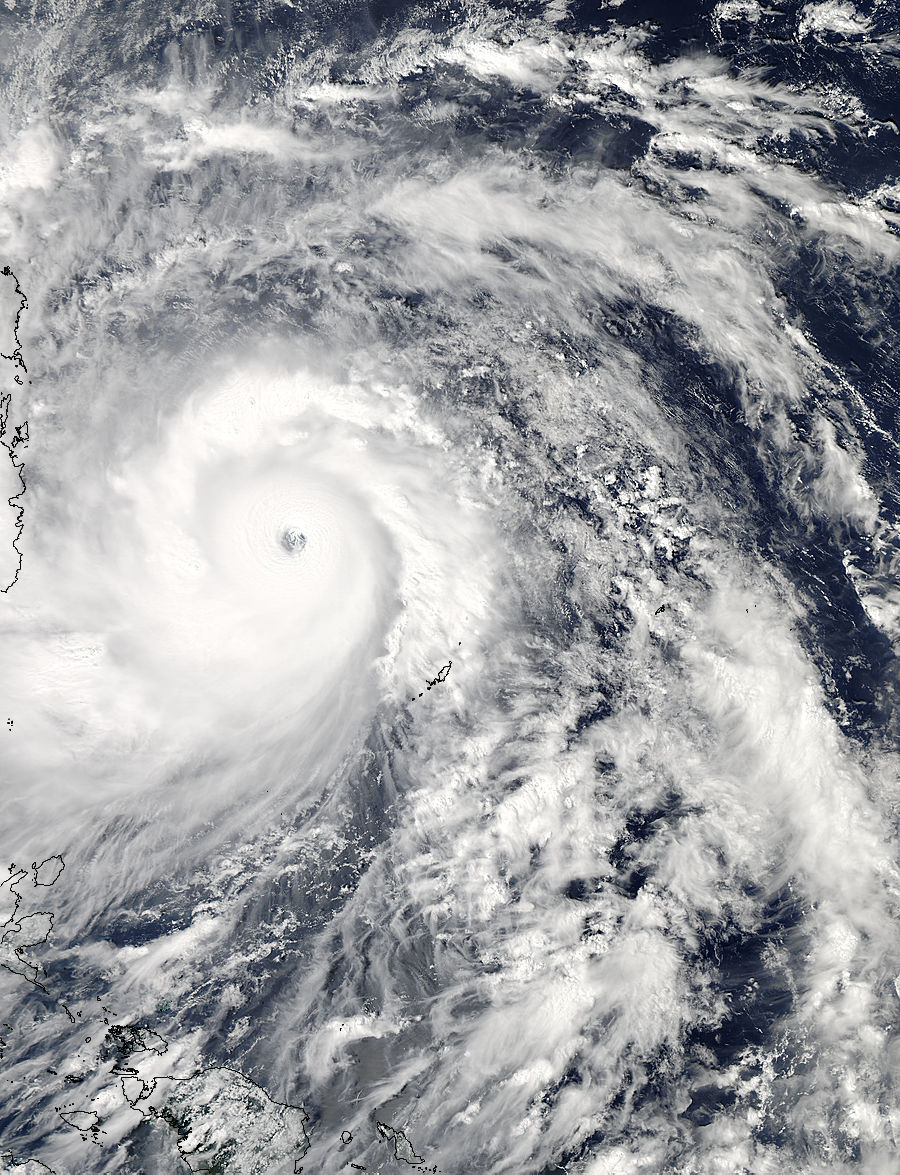
Super Typhoon Haiyan approaching the Philippines. (NASA)
CURWOOD: So what is the risk that we will see more superstorms in the years ahead as the planet warms and sea levels rise? To get some answers, we called Kevin Trenberth. He's a senior scientist at the US National Center for Atmospheric Research, to ask him what we can learn from Supertyphoon Haiyan.
TRENBERTH: Certainly this was a very strong, and very big storm, very intense storm, and the unusual part of it perhaps is that it made landfall, it barreled right through the Philippines whereas we’ve had certainly as big storms before but not where they made landfall.
CURWOOD: And by the way, the difference between a hurricane and a typhoon is?
TRENBERTH: Well, a hurricane is a same animal in the Atlantic. A typhoon is in the Pacific Northwest and another name for them is cyclone, for instance, in the Bay of Bengal.
CURWOOD: Now, here in the Atlantic this year it was a relatively calm hurricane season, but then this collosal typhoon crops up in the Pacific. What’s the relationship, if any, there?
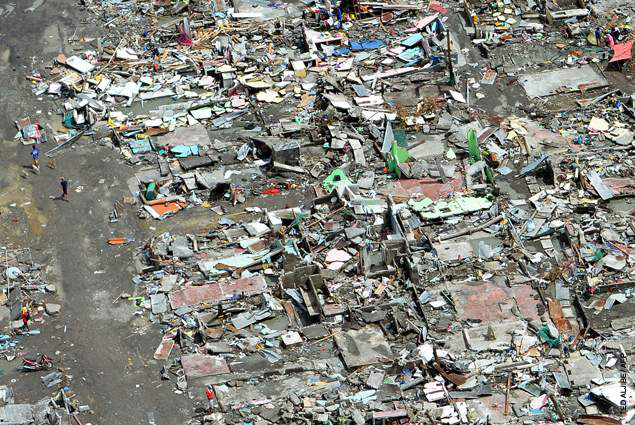
An aerial photo of widespread damage from Typhoon Haiyan. (Noel Celis/ US AID)
TRENBERTH: Well, there has been other activity in the Pacific as well, there was a very big typhoon that just brushed by Japan a short time ago, and, of course, a lot of activity over in the Bay of Bengal that went into India. And so there has been activity elsewhere, and frequently when that happens it does have a supressing effect on the Atlantic. In other words, there’s a little bit of a competition around the tropics as to where the activity is going to occur.
CURWOOD: Now this area near the Philippines is no stranger to typhoons, why is that?
TRENBERTH: The Pacific Northwest region is where some of the warmest water occurs in the world. To the east of the Philippines the sea temperatures have been running as high as about 85 degrees Fahreinheit, and this is about as warm as the ocean gets. If it gets very much above there it quickly gets knocked down again because of evaporative cooling with the storms that are attracted to that region. And in fact, sea level is higher over there. In the last 20 years, sea level has been going up in that region faster than anywhere else in the world. You might say, it’s really the hotspot of the world.
CURWOOD: So you’re saying the ocean near the Philippines is actually experiencing a higher rate of sea level rise. Why is that?

Survivors of Typhoon Haiyan in Leyte province. (Photo: Ted Aljibe/ US AID)
TRENBERTH: There is a change in the weather patterns related to the phenomenon that is widely known as La Niña where there is cooler sea surface temperatures in the central and eastern Pacific, but warmer than average sea surface temperatures in the west. The trade winds are stronger...they’ve gotten stronger over the last 20 years compared with, say, the previous 30 or 40 years. And the sea level has piled up over there. So the sea level has gone up in the region just east of the Philippines by about 20 centimeters, about eight inches, over the last 20 years or so, whereas globally sea level has gone up about two-and-a-half inches.
CURWOOD: Wow. So that amount of sea level rise must make storm events like this typhoon even more severe there.
TRENBERTH: This is certainly true when it comes to the storm surge. So sea level rise combined with perhaps a more intense storm and heavier rains contributes to damage that previously would not have occured.
CURWOOD: Now help me understand what’s going on here. Of course, we can’t attribute any single event to climate change, but what in your view is the relationship here between this dramatic storm and a warming planet?
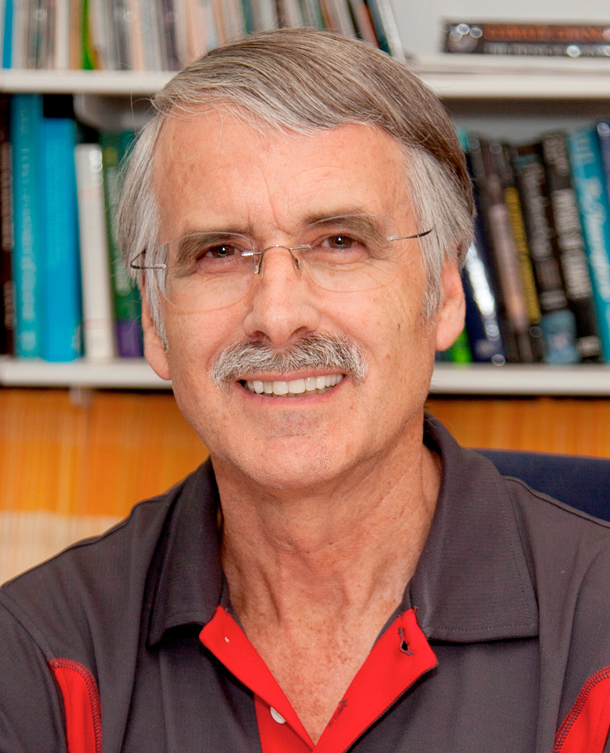
Kevin Trenberth, Distinguished Senior Scientist of the National Center for Atmospheric Research (photo: NCAR)
TRENBERTH: Well, the environment in which these storms are occuring is changed because of climate change. The sea temperatures are higher, and the atmosphere above the ocean is warmer and moister as a result, and these storms reach out and grab that moisture, bring it into the storm, and as a result, the storm tends to be more intense, there are heavier rainfalls, there’s greater flooding associated with that, and the storm surge, because of a higher sea level, is also greater than it otherwise would be.
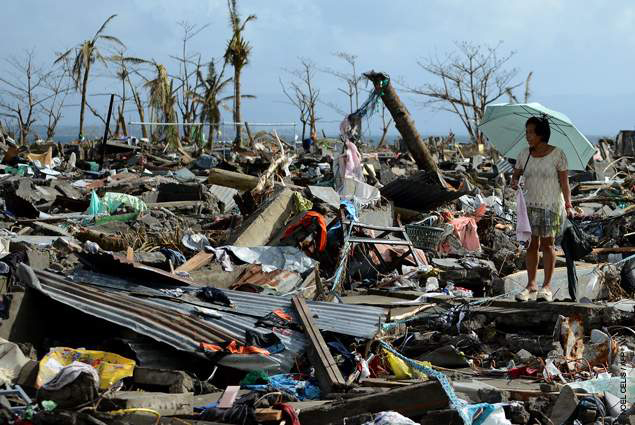
A survivor walking among debris from homes destroyed by typhoon Haiyan in Leyte, Philippines. (Photo: Noel Celis/ US AID)
CURWOOD: Kevin Trenberth, what do you expect in terms of typhoons and cyclones and hurricanes going into the future?
TRENBERTH: The understanding we have at the moment is that we do expect bigger, more intense, storms, however, there may well be fewer such storms overall, and one of the reasons is that if you have one really big storm, it churns up the ocean, it takes heat out of the ocean, so the ocean gets cooled off, and it creates a less favorable environment for the next storm. And so, one of these big storms can perhaps replace three or four somewhat smaller storms. And so we may end up with fewer storms, but when they do occur, look out.
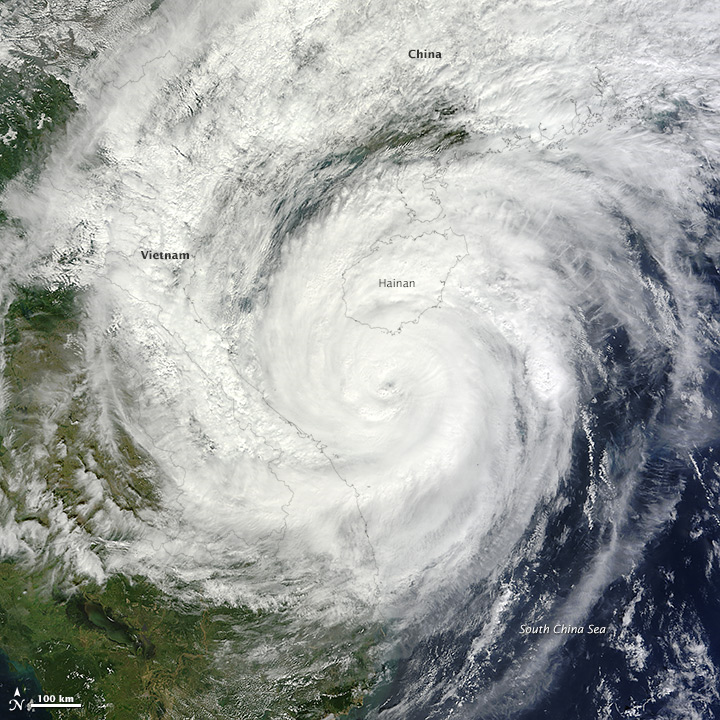
Typhoon Haiyan moving through Southeast Asia. (NASA)
CURWOOD: Kevin Trenberth is a distinguished senior scientist at the US National Center for Atmospheric Research in Boulder, Colorado. Thank you so much for taking this time.
TRENBERTH: Thank you very much, Steve.
Related link:
More about Kevin Trenberth
[MUSIC: Booker T and The MG’s: Melting Pot” from Melting Pot (Stax Records 1983) Happy Birthday Booker T Jones 11/12/1944]
CURWOOD: Coming up...coal opponents with money score in a key county election in Washington state. Keep listening to Living on Earth.
[CUTAWAY MUSIC: Buck Clayton: “All The Cats Join In” from Jam Sessions From The Vault (Columbia Records 1988) Happy Birthday Buck Clayton (11/12/1911 – 12/08/1991)]
Coal Loses Ballot Test
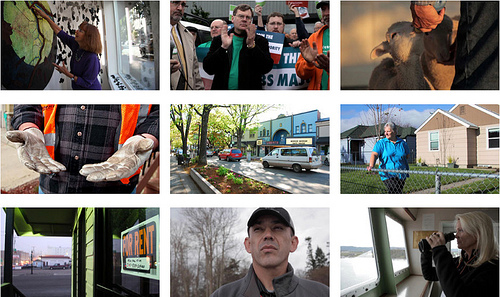
The proposed coal terminals have been extremely controversial. Earthfix’s Voices of Coal project documents what everyday people in the Pacific Northwest think about the project. (photo: Earthfix)
CURWOOD: It's Living on Earth, I'm Steve Curwood. Local elections can have national implications, and nowhere is that more obvious this year than the results of a seemingly obscure election in Washington state’s Whatcom County. The focus is on the Whatcom County Council because it will eventually decide whether or not to approve the largest of the proposed coal export terminals on the West coast. Reporter Ashley Ahearn of the public media collaborative EarthFix followed this election closely, and she’s on the line now. Welcome back to Living on Earth.
AHEARN: Hey, Steve.
CURWOOD: So, some press accounts say that race in Whatcom County was a race between those who are in favor of developing a massive coal export terminal there and those who are against it. Was it that clear?
AHEARN: You know, the thing about county council members and county council elections is the county council is a semi-judicial body that’s supposed to be nonpartisan and will ultimately make decisions about the permits for the docks for the Gateway Pacific Terminal, and as you know, that’s the largest coal export terminal on the west coast. And so, the interesting thing to watch in this campaign season was that the candidates were all talking about the coal terminal, but they weren’t allowed to come out directly and say how they would vote on it because they didn’t want to sort of reveal their hand as semi-judicial members of this council eventually.

Trains bring coal from Wyoming to the Pacific Northwest Coast (photo: EarthFix)
So you had this interesting thing happening where there was code for how they might vote. People would say things like, “Well, I’m pro-development or pro-jobs or I’m pro-environment, pro-conservation.” And you had to kind of interpret that as how they might vote on the terminal. That being said, the money followed a very clear line. There were four candidates who were backed by the Republican party and a PAC that was funded by coal company money and terminal company money. And then there were four candidates that were backed heavily by Whatcom Democrats and the Washington Conservation Voters. So the money, I think, shows a clear picture when it comes right down to it.
CURWOOD: Let's talk about the money that’s involved here. County council is not typically a race that gets much attention, or money, for that matter. But I gathered that's not what happened there. How much was spent on this race, overall?
AHEARN: Well, to give you some context, the average county council member will spend $20,000 to $30,000 to get elected, and there was close to a million dollars spent on this campaign total for four candidates. So we’re looking at $250,000, $200,000 per candidate in fundraising and spending to win this election, and it was pretty interesting to see where the money was coming from, and perhaps most interestingly in terms of campaign finances, more money came in from the environmental side than from the coal company or fossil fuel industry side.
CURWOOD: But when you add it all up, Ashley, this election was about coal?
AHEARN: You know, I think it depends on who you ask. For Washington Conservation Voters, this was very clearly an election that’s about coal, and they have said this was one of the most important elections for them in the state, and some have said nationally, for any environmental group that is watching climate change issues on the ballot, was this Whatcom County council election. And so, when I talked to Brendon Cehovic, he’s the Executive Director of Washington Conservation Voters, he made it pretty clear that, yes, this was indeed about the coal export issue and climate change largely.
CEHOVIC: Look, we have four candidates who just lost their jobs because they supported coal exports in the northwest. If I was an elected official anywhere in the state, I would pick my head up and notice that.
AHEARN: But then on the more conservative, pro-development side, you have this PAC known as Save Whatcom which is funded by coal companies and terminal companies - majority funding is coming from those groups. And I talked to Kris Halterman, the head of the PAC, and she said coal wasn't the biggest issue, and the environmentalists used it to steal the election.
HALTERMAN: The money bought the election and painted a picture of the candidates that we supported as being they would vote for coal when what they would do was stand up and fight for the residents and the community and the property owners of Whatcom County.
CURWOOD: OK, Ashley, so did money buy this election?
AHEARN: Short answer, yes. The candidates that had more money spent on them won the election, and those were the four environmental candidates. Long Answer, yes, but there was a huge grassroots effort that helped those candidates win the election. The environmental side definitely outdid the pro-coal side, or pro-development side in this campaign in terms of just sheer numbers of doors knocked on, phone calls made. Whatcom County Democrats and Washington Conservative Voters made more than 47,000 phone calls and knocked on more than 26,000 doors. That’s a lot of doors in a pretty rural and small county.
CURWOOD: So when does this council actually weigh in on the coal terminal?

Ashley Ahearn covers science and the environment for KUOW and EarthFix, a multimedia reporting project based in the Northwest. (Photo: EarthFix)
AHEARN: I mean, that’s the funniest thing in all of this I think is the environmental impact, the environmental review for the Gateway Pacific Terminal has begun, but it could take more than two years for that to be completed. So these county council members may not be voting on these permits for the docks at Cherry Point where the terminal will be built for more than two years.
CURWOOD: Will they still be in office or is there another election to go?
AHEARN: Well, if there is you can be sure it will be getting just as much attention as this one did.
CURWOOD: That's reporter Ashley Ahearn of the public media collaborative EarthFix. And by the way, we must congratulate Ashley on recently winning a AAAS Kavli Journalism Certificate of Merit for her series on coal dust.
Related links:
- Check out more from EarthFix
- Listen to Ashley’s EarthFix piece on the Washington elections
Fracking Boosts Plastic Production

Williams Olefins plant in Geismar, LA uses natural gas to produce ethylene and propylene, building blocks of plastic. An explosion there in June killed two workers and injured more than 100. Photo: Reid R. Frazier
CURWOOD: Well, coal use in the US continues to decline, mostly thanks to the huge expansion in fracking for natural gas. The fracking boom has also helped fuel a renaissance of chemical plants in Louisiana, and could bring such industry to shale gas country. And that means jobs, lots of jobs at these chemical plants. But in this report from the Gulf Coast, Reid Frazier of the public radio project The Allegheny Front finds the newly abundant jobs also come with abundant risks.
[INSIDE A CAR DRIVING ON THE ROAD]
FRAZIER: On a rainy morning, Mike Eades drives around Geismar, Louisiana. It's about halfway between New Orleans and Baton Rouge, and it's in the middle of Louisiana's so called 'chemical corridor'. It's a 60-mile stretch where roughly a quarter of the country's petrochemicals are made. Eades points out several large construction projects at hulking industrial plants.
Eades is director of the local development corporation. His job is to bring new business to the area.
He pulls over. Workers in the distance are preparing a site for construction.
EADES: This is about a 225 acre site.
FRAZIER: The site will house two plants for the company Methanex. Methanex is the world's largest producer of methanol, a basic chemical made from natural gas. The total price for the project is over a billion dollars. But the price itself isn't the most eye-popping thing about these new plants.
EADES: They are just actually just dismantling another plant in Chile and moving it to this area.
FRAZIER: Eades has been in the business for 30 years. And he's worked in seven different states. In the last year alone, he's seen about $3.6 billion in newly announced projects here.
EADES: And that's by far the most that....that I've ever experienced in my career, in any location.
FRAZIER: These projects are all happening because of the fracking boom. It's made natural gas cheap and abundant. And chemical companies use natural gas as a raw material.
While the boom comes at a good time for the region's economy, people here also know: these plants can be dangerous. This fact was driven home one morning in June. Antionette West was lying on her couch in Geismar.
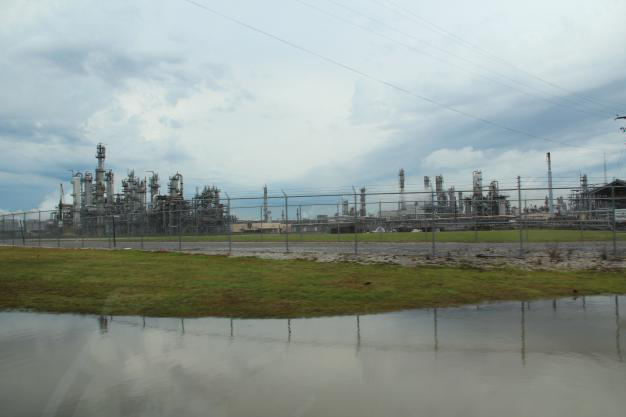
Geismar, Louisiana is part of a 60-mile stretch along the Mississippi River where nearly a quarter of the nation's chemicals are produced. Photo: Reid R. Frazier
WEST: The house shook, and I got up and I went to the door.
FRAZIER: She thought it was an explosion at a nearby vinyl plant, which caught fire last year. But she couldn't see any smoke when she looked in that direction. Then she looked behind her trailer.
WEST: All I seen was black smoke.
NEWS REPORTER ON TV: A massive explosion and fire at a chemical plant rocks the Geismar community near Baton Rouge...
FRAZIER: It was the Williams Olefins plant in Geismar. One worker died in the explosion, another died the next day from his injuries. Over 100 were hurt.
The plant makes ethylene and propylene. It's the same kind of plant - an ethane cracker -- that Shell Chemical has proposed building in Western Pennsylvania. Ethylene and propylene are the building blocks of plastic and other chemicals. They're also highly flammable. The company said a rupture in a heat exchanger caused the explosion. For West, it was another moment where she wished she didn't have to live so close to a chemical plant.
WEST: If I could move today I would move. I'm not going to lie. I would get out of here.
FRAZIER: But this is the only place she can afford. The company reported releasing 31,000 pounds of chemicals in the blast, mostly propylene, which can burn the eyes and skin. But the Louisiana Department of Environmental Quality - the state regulator - said that its air monitoring taken that day showed no unsafe levels of chemicals in the air near the plant.
LeRoyal Ealy lives two doors down from West. He's an electrician who's worked in many of the plants in the area. As his family gets ready for dinner one night, he says he isn't worried about air pollution from the explosion.
EALY: I didn't think nothing really seriously would happen to me over here. I was worried about people in there.
FRAZIER: But his wife, Elaine Claiborne, says she was concerned about what came out of the plant during the blast.
EALY: It might not affect us right now, but later on in the year? Yeah, I've got concerns.
FRAZIER: Ealy says worries about pollution or explosions are just something you have to live with if you live near a chemical plant. He says, overall, it's worth it.
EALY: It's good to have them, but there's a risk in everything.
FRAZIER: Those risks are why the industry needs stronger oversight, says Kim Nibarger. He's with the United Steelworkers, which represents thousands of chemical and refinery workers.
NIBARGER: Take a coffee can, fill it about half full of gas and put it on your barbecue -- that's not much different than what's going on in these facilities. It's a dangerous, dangerous operation.
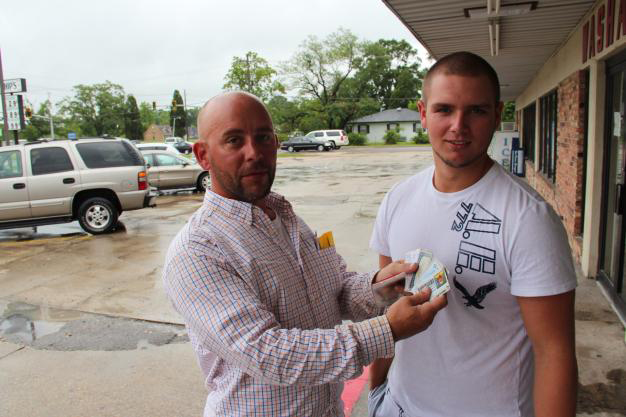
Joshua Gray, a carpenter and Josh Gibbons, a carpenter's apprentice came to Geismar, where construction jobs are plentiful. Gray holds OSHA and TSA cards-safety and background certifications needed to work in construction in the plants.Photo: Reid R. Frazier
FRAZIER: The Obama administration is paying closer attention to the issue of chemical safety. In August, the president signed an executive order mandating greater communication and enforcement among federal agencies who oversee chemical plants. He was responding to a fertilizer explosion in April in West, Texas. That blast killed 15.
Despite high-profile explosions, the chemical manufacturing industry is comparatively safe, according to records from the Occupational Safety and Health Administration. The industry has a fatality rate roughly half the national average for other industries. And it's much much safer than jobs like mining, forestry, or farming. But Nibarger says those numbers can be deceiving.
NIBARGER: No, I think the industry is more dangerous than it seems.
FRAZIER: That's because those injury and fatality rates don't always include contractors working at the plant. When those are accounted for, he says, those injury numbers are actually higher. But an industry trade group says even if outside workers are taken into account, the chemical sector is relatively safe and it's getting safer. The American Chemistry Council says its members have had a precipitous drop in accidents - 58 percent-since the 1990s. Scott Jensen of the chemistry council says those numbers include contractors.
JENSEN: While I think in the public's mind there is a renewed focus on safety, I think for our industry, that focus has always been there.
FRAZIER: Concern over safety issues aren’t likely to stop the chemical expansion anytime soon. In Geismar, the plants keep growing, to take advantage of cheap shale gas. And they're attracting workers, like Joshua Gray. Gray moved here from Baton Rouge to work as a carpenter. On a recent afternoon, he stopped in a parking lot on his way out of a laundromat.
GRAY: The economic part of it is outstanding. The money's here -- there's no reason to leave here -you're gonna make some money right here, for the next 10 years. It's equivalent to a gold rush.
FRAZIER: Gray was with Josh Gibbons, an 18 year old from Baton Rouge. Last week Gibbons was delivering pizzas. Now he's working as a carpenter's apprentice.
GIBBONS: I'm there for learning, really. I'm there for the money. But it's not that great at the moment. $14 an hour, starting. But it's my first time in the plant.
GRAY: You can't beat it. You now -- he was delivering pizzas a week ago, and now he's making $140 a day.
FRAZIER: The irony of all this for Joshua Gray is he’s not really in favor of the expansion. He thinks the plants are releasing too much air pollution and they are bad for the environment.

LeRoyal Ealy with his wife Elaine Claiborne and daughter Lajanaye Ealy, 6, live in Geismar, where he works as an electrician. Ealy thinks dangers of explosions and pollution are part of the bargain but Claiborne worries about the long-term effects from pollution released during the Williams Olefins explosion. Photo: Reid R. Frazier
GRAY: I don't, really in favor of none of it. It's not good for the environment, it's really terrible, but when you need a job you do what you got to do to make money.
FRAZIER: And Gray says he'll be here, as long as the money keeps coming.
CURWOOD: That's Reid Frazier reporting from Geismer, Louisiana. Reid's story comes to us from the series, The Coming Chemical Boom, produced by The Allegheny Front in Pittsburgh, with support from the Fund for Investigative Journalism.
Related link:
Check out the rest of the Allegheny Front’s series on the chemical boom
[MUSIC: Bill Frisell “We All Love Neil Young” from Big Sur (Emarcy Jazz 2013)]
Beyond the Headlines

The Tea Party hasn’t been an ally to environmental causes, until now… (photo: bigstockphoto.com)
CURWOOD: Time now, to check in with Peter Dykstra, publisher of the Daily Climate and Environmental Health News, for a few stories from beyond the headlines. He and his team comb the web for curious tales of environmental change from around the planet and often find little-noticed topics that bear watching as they emerge over time. Peter Dykstra joins us now on the line from Conyers, Georgia.
CURWOOD: Hi there, Peter!
DYKSTRA: Hello, Steve! Got a question for you to start. Are you a Marx Bros’ movie fan?
CURWOOD: Well, hey, anytime I need a handy insult, nobody like Groucho Marx to quote. Remember that line, “I never forget a face, but in your case I’ll make an exception.”
DYKSTRA: That line works very well on radio, doesn’t it?
[LAUGHS]
DYKSTRA: Well the reason I bring it up is the Marx Brothers first movie, this is back in the late 1920s, called “The Cocoanuts,” and it was a satire - everything they did was a satire - of all of the real estate swindles that were going on in Florida at the time. What would happen is that people up north would see this beautiful magazine ads about Paradise Resorts for sale in Florida, they’d buy the site unseen, and find out that the paradise retirement home that they bought turned out to be useless swampland, and it was a constant swindle.
The Tampa Bay Times this past week reported what could be a 21st century version of that kind of swindle. It focuses on America’s biggest homebuilding firm, D.R. Horton, and the Times reported that they sold 2,500 homes in the Tampa Bay area over the last few years, and they quietly kept the mineral rights of what’s under those homes to themselves. Whether you find natural gas through fracking in the future, whether you find oil, maybe even diamonds...anything that would be found in the future goes back to the homebuilder rather than the homeowner. So you had 2,500 homeowners, according to the Tampa Bay Times, that had pre-qualified for an alleged swindle.
CURWOOD: So what would Groucho do and his brother do?
DYKSTRA: They’d probably make a movie and make some wisecracks and insults about land developers.
CURWOOD: [LAUGHS] OK. So let’s see...there’s another story from your neck of the woods about what we would call “strange bedfellows”.
DYKSTRA: There are no stranger bedfellows on this beat than seeing the Tea Party and the Sierra Club together, it’s like dogs and cats, like Romulons and Clingons, Yankees and Red Sox fans.
Debbie Dooley is to me one of the most interesting figures on the environment beat this year. She heads the Atlanta Tea Party Patriots, one of the tea party groups here in Georgia, and she’s formed an Alliance with the Georgia Sierra Club. They call it the green tea party. What they’re doing is challenging the huge utility in these parts, Southern Company and Georgia Power, which is their subsidiary here in Georgia, saying that they are uncompetitive and resisting using or investing in solar power while they’re running almost a billion dollar deficit and are over budget on two new nuclear plants that they’re building.
Debbie Dooley recruited a Public Service Commissioner here in Georgia named Bubba McDonald – yes, it’s an elected official named Bubba – and together they worked with the Sierra Club and other groups and are on the brink of compelling Georgia Power to invest in solar energy.
CURWOOD: Hmmmm...is this happening anywhere else? And are there more solar Bubbas out there?
DYKSTRA: Well, Bubba’s kind of a politically magic name here in Georgia, but if you’re in Arizona, a more magical name is ‘Barry Goldwater’ in politics. Barry Goldwater Junior, the son of the iconic conservative senator, according to Bloomberg News in a story this week, is helping to lead an effort in Arizona to get their utilities to drop a surcharge for carrying solar power, something that discourages the development of solar in Arizona.
CURWOOD: And finally, this week, Peter, you have a special anniversary to mark for a very special hoax, I gather.
DYKSTRA: We have an anniversary...sixty years ago this week, scientists put the last nail in the coffin of what I think is the greatest scientific hoax ever, The Piltdown Man.
CURWOOD: The Piltdown Man? What’s that?
DYKSTRA: Back in 1912, there were some bones found in the UK near the Piltdown Golf Course in East Sussex. There was a media frenzy that followed, that the “missing link” had been found anthropologically. And the local press went kind of crazy on this because they were also glad the missing link they found was British. The Piltdown Man became a phenomenon, you might call him a 500,000-year-old rock star. Now, these days, 500,000-year-old rock stars are a little more common in the UK, but it was a big deal back in the early part of the 20th century.
CURWOOD: [LAUGHS]
DYKSTRA: Forty years of this, back and forth over The Piltdown Man and whether it was a real discovery, happened. It wasn’t until 1953, 60 years ago this month, that it was revealed that some of the bones were fixed. They were chemically treated to look like they were half a million years old when actually they were a few hundred years old.
CURWOOD: So they exposed the hoax, but who did it and why?
DYKSTRA: They were never able to figure out who the real hoaxer was, there are a couple of suspects, one of them was one of the early scientists. Another one was a disgruntled employee at the British Natural History Museum. But it remains an open mystery. All we know is that it was a hoax and people fell for it.
CURWOOD: Peter Dykstra of Environmental Health News and the Daily Climate. Thanks so much, Peter.
DYKSTRA: Thanks, Steve.
Related link:
Peter Dykstra is the editor of the Daily Climate
[MUSIC: Neil Young “Drifting Back” from Psychedelic Pill (Reprise Records 2013) Happy Birthday Neil Young (11/12/1945)]
CURWOOD: Coming up...the link between tropical and arctic ice. Stay tuned to Living on Earth.
ANNOUNCER: Funding for Living on Earth comes from the Grantham Foundation for the protection of the environment, supporting strategic communications and collaboration in solving the world’s most pressing environmental problems. The Kendeda Fund, furthering the values that contribute to a healthy planet, and Gilman Ordway for coverage of conservation and environmental change. This is PRI, Public Radio International.
[CUTAWAY MUSIC: Hampton Hawes: “The Awful Truth” from Four (Contemporary Records 1958) Happy Birthday Hampton Hawes (11/13/1928 – 05/22/1977)]
Polar Bear Attacks on the Rise
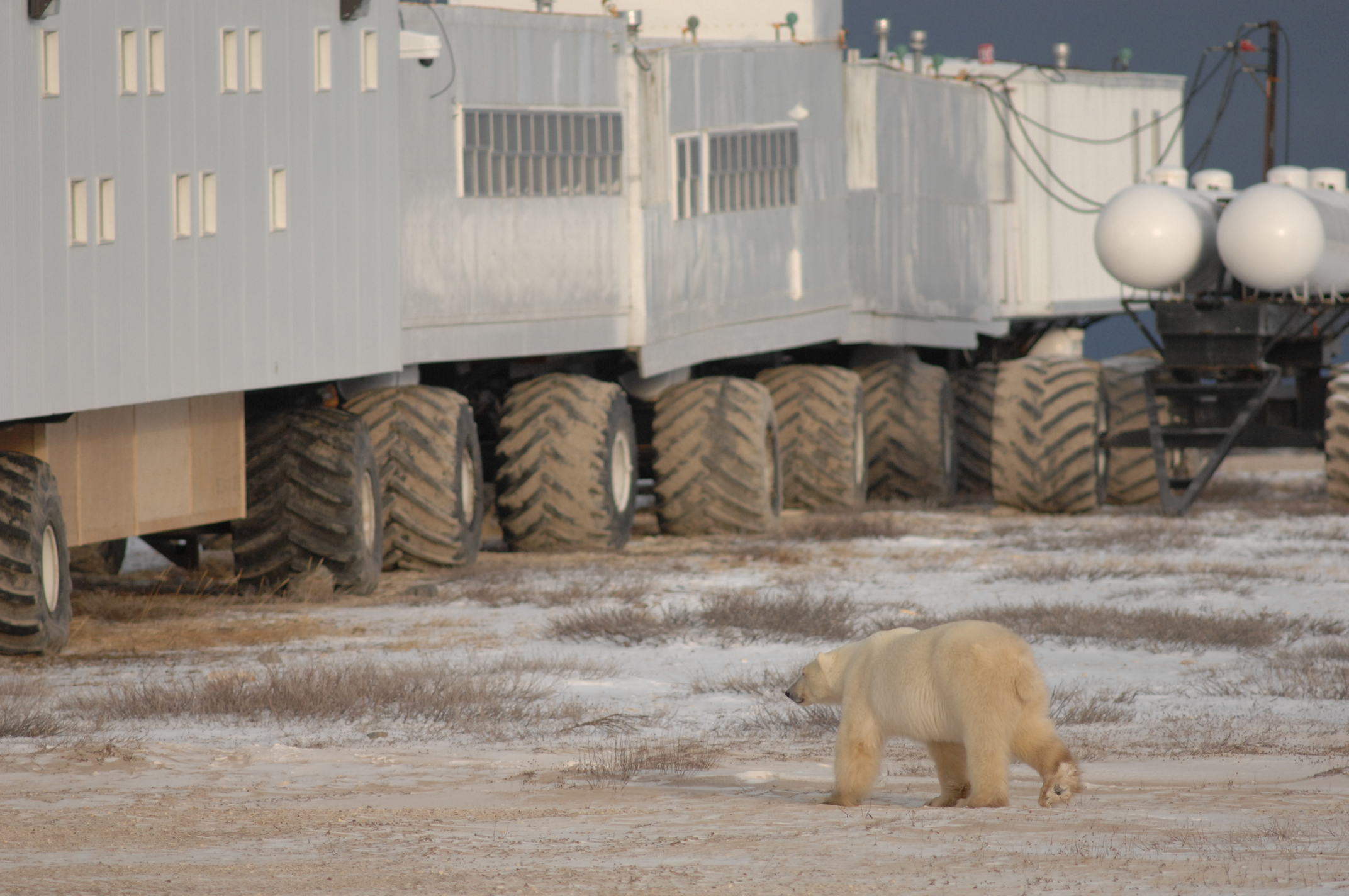
As the Hudson Bay freezes over later in the year, polar bears are coming in contact with humans more and more (photo: Andrew Derocher)
CURWOOD: It's Living on Earth, I'm Steve Curwood. Life for the famous polar bears of Churchill, Manitoba, can be a mix of feast and famine. When there's ice, the bears fatten up by catching ring seals that pop up to breathe in holes in the ice. But when summer melts the ice out of Hudson Bay, the seals are too fast to catch and the bears mostly go hungry. And with ice taking longer to come back , these southernmost white bears are going hungry well into the fall, and a couple of recent attacks on people have experts concerned. Andrew Derocher is a Professor of Polar Bear biology at the University of Alberta, and he says the attacks have caught people off guard.

Two polar bears (photo: Andrew Derocher)
DEROCHER: It's an unusual event, we have to really go back several decades before we’ve actually had a fatality in Churchill. Fortunately, both cases that have happened this year, nobody’s been killed. It is unusal though to have people attacked in the town of Churchill itself.
CURWOOD: Well, describe these attacks for us. How many victims did you say? Three?
DEROCHER: We’ve had three people injured, two separate events. The first one was an individual out late at night on his own and he was attacked right in front of the bakery. This is the famous cell phone case where he pulled out his cell phone and I guess the flash sort of startled the bear, and it backed up, bumped into a planter and kind of ran away. Well, that bear is now in a zoo in Winnepeg, Manitoba, so that one wasn’t shot.
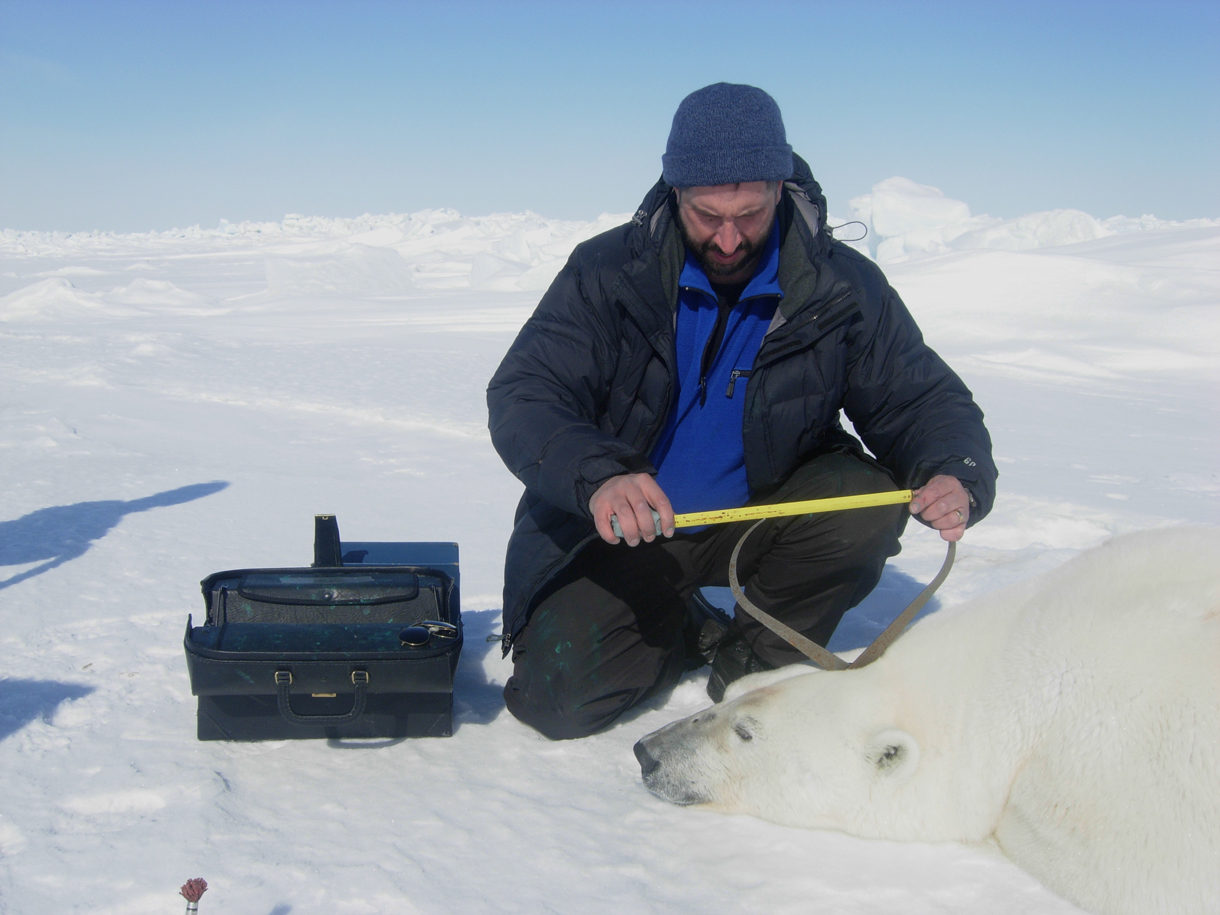
A polar bear viewing vehicle. Tourists flock to Churchill every year to catch a glimpse of the endangered polar bear. (photo: Andrew Derocher)
The most recent event that occurred was a little more serious, and there was a woman being attacked and another person came out to assist, and then he was attacked by this bear, and this seemed like quite an agressive situation and the information’s still a bit sketchy. It ended up that two bears were shot. It seems that there was a case of a bear being in the wrong place at the wrong time. That was a mother that actually had a cub with her. She was shot, and it looks like they did shoot a young male that was the bear responsible for the attack, and from all accounts that are going on right now, there are a lot of young skinny males around in the Churchill area this year, which is a bit unusual. Usually, we don’t see that many bears in town.

A bear coming in contact with people (photo: Andrew Derocher)
CURWOOD: Well, we saw this year Arctic ice retreat to, well, the sixth most extreme extent. That is, there have been worse years, but on the other hand, out of the last 30 or 40 years, this was the sixth worst one. How much does the lack of ice have to do with all this?
DEROCHER: Well, it’s an interesting challenge because when we talk about the worst ice years, those are typically measured in September, and that really affects bears further north more than it does directly in the Hudson Bay ecosystem because the Hudson Bay system has been ice free for as long as people have known in the summertime. The challenge of the Hudson Bay system is more that what’s happening is, the general climatic warming is causing an earlier melt in the springtime, and then a later freeze up in the Autumn.
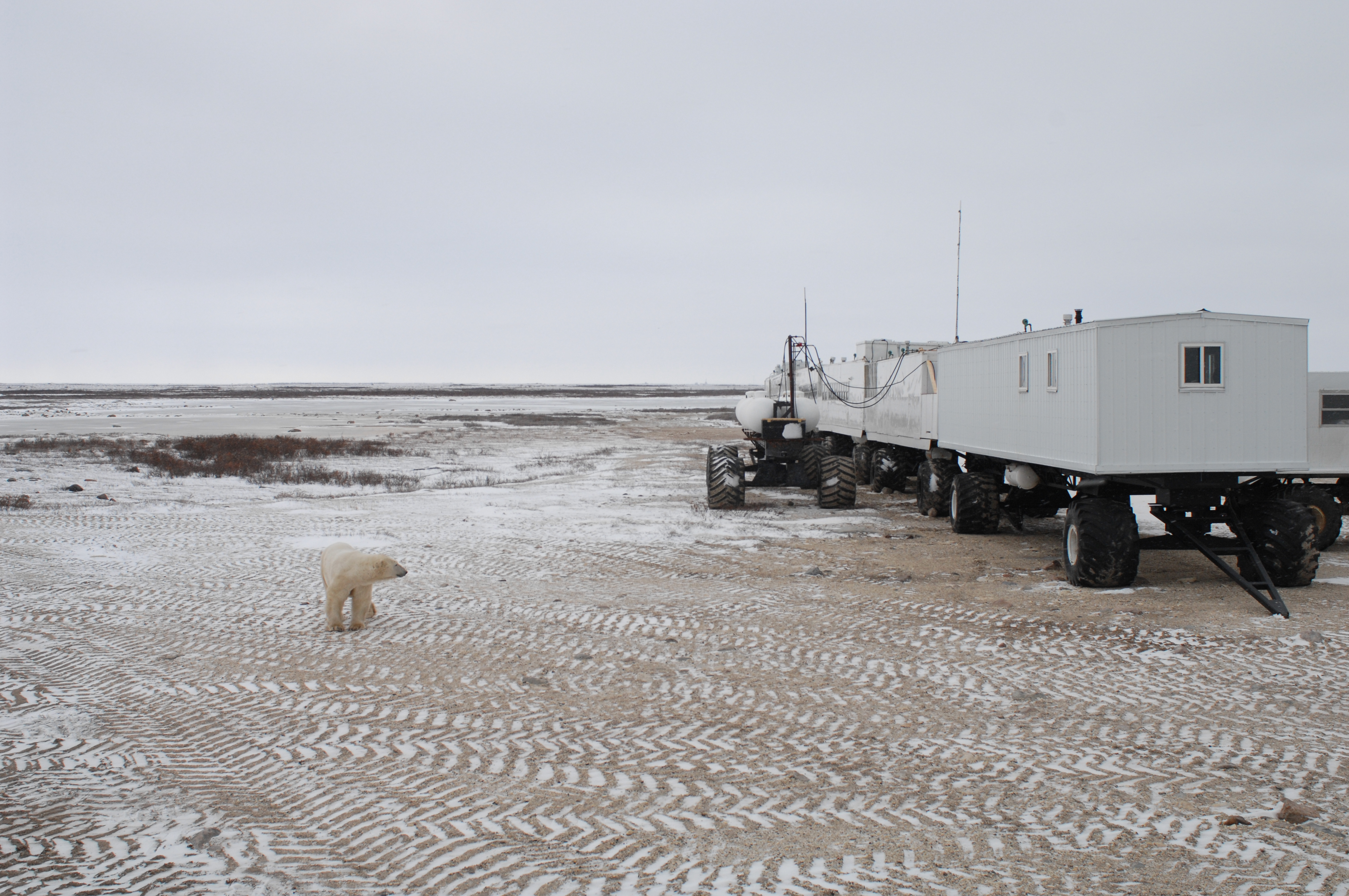
The loss of sea ice has polar bears coming on shore (photo: Andrew Derocher)
So the challenge here is that bears are being pushed. We’re now starting to cut into the feeding time in the spring out on the sea ice, and then we’re making them go longer and longer on shore without access to their food, so they can only bring so much fat ashore with them, and that’s the real problem here, is that these bears are running out of energy, and of course, it doesn’t matter where you live - if it’s grizzly bear country or black bear country - you know when there’s a food crop failure and the bears get hungry, they come around communities, and it’s the same process we’ve got in the Arctic with polar bears.
CURWOOD: So traditionally, how have humans and bears gotten along there in Churchill? You’ve been there for many, many decades. What’s it like?
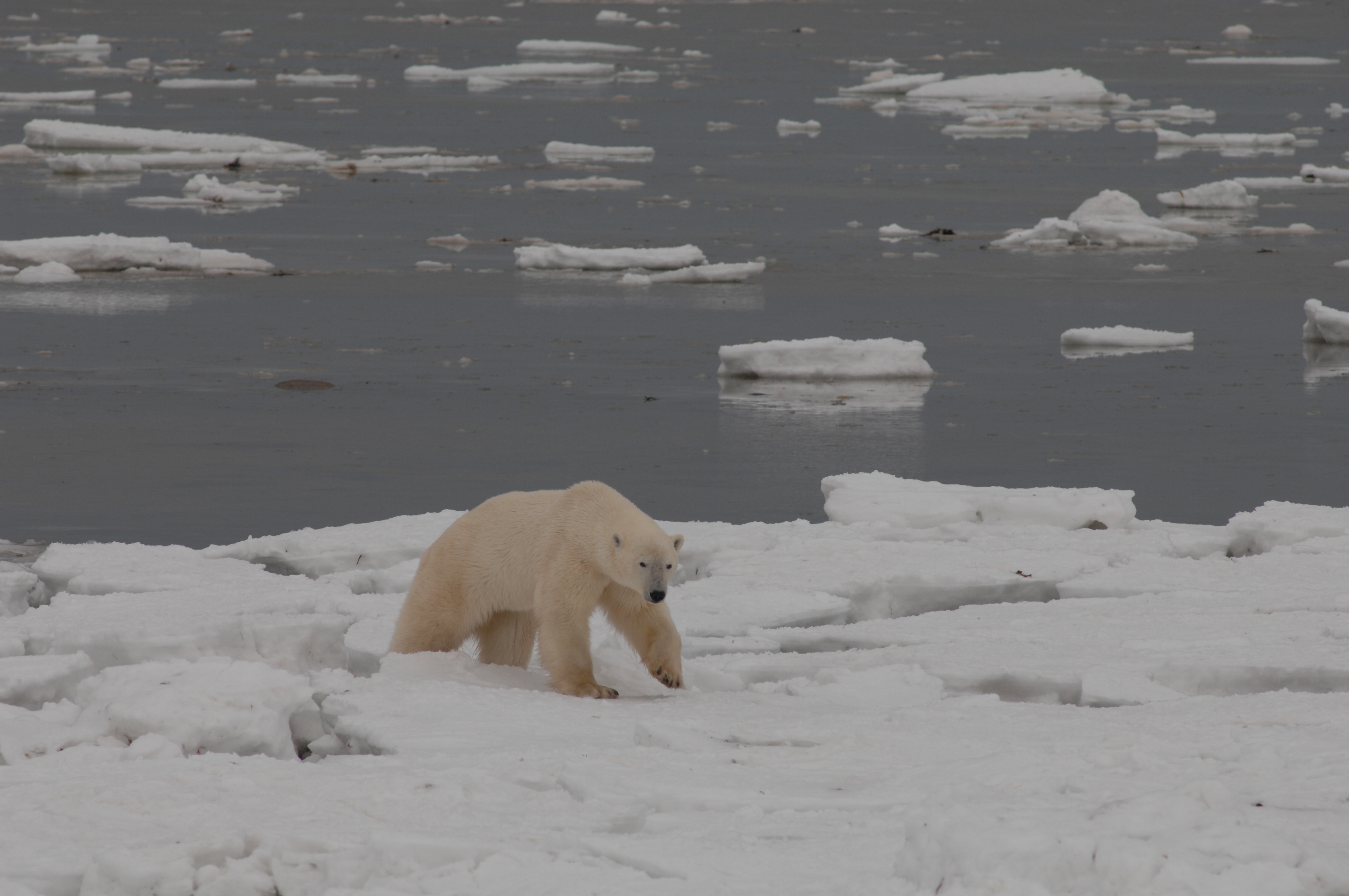
Scientist Andrew Derocher measuring a tranquilized polar bear (photo: Andrew Derocher)
DEROCHER: It’s a pretty nice relationship. I mean, the polar bears come back and the tourists bring a lot of money with them when they come. There’s a bit of an uneasy sort of respect that goes on. There are people in Churchill that are pretty careful around polar bears for the most part. Probably, one of the big issues is that the polar bear alert program has been incredibly successful. The government of Manitoba puts amazing resources into keeping the bears away from town, but it’s not a foolproof system and some bears do get into town and what a lot of polar bear scientists and managers have been saying is that there’s a changing scenario going on and that the bears are not going to behave as they used to behave.
In the years past, when these bears were fat and sassy coming off the ice and in good shape late into the fall, they had no interest in being around people, and they were very wary of humans. Now, of course, that the bears are leaner, they’re starting to look for food resources, and we’re seeing this right across the Arctic, it’s not just in Churchill, it’s in other communities like Resolute in the Canadian Arctic, parts of Alaska as well. It’s everywhere.
CURWOOD: What does this mean for tourism in Churchill?
DEROCHER: Well, in the short term, the tourism industry is going to be quite vibrant. There’s no question there’s a bit of this attitude of last chance to see what’s going on, so if people want to see polar bears relatively inexpensively, Churchill is still by far the best place to go. I was talking to people there this morning. There’s lot of bears around, they seem to be doing quite well, but that population from all indications is on a pretty steady decline, and longer term, it’s not going to be there, so people who want to see bears are going to have to go further and further north over time.
CURWOOD: How long do you think that the tourism industry has for bears there in Churchill?
DEROCHER: Well, you know, that’s the challenge here, and one of the concerns we have is it would only take one very bad year, so a very early melt and a very late freeze up to see a major decline, and some of the energetics modeling that we’ve done on the bears suggest we could see easily a decline of 50 percent in a single year. By all accounts, it could be next year, it could be the year after, it could be ten years away. It’s really hard to predict. There’s a lot of noise in the Artic sea ice systems, and the bears respond directly to the sea ice.
CURWOOD: So professor, overall, how are polar bears faring throughout the world?
DEROCHER: Well, we’ve got 19 different populations in the circumpolar Arctic, and some of them are doing just fine. We’ve got recent inventory information from the population that’s north of Hudson Bay, an area called Fox Basin, it indicates that population is quite stable. Nonetheless, in that area, we’re seeing changes in sea ice, and we think that we’re on the cusp of changes in the next population north. But if you go to the other populations around the Arctic, some of them are going to be doing well for many decades to come, and some areas may actually see some improvement in habitat. We haven’t noted that anywhere yet, but it’s still conceivable to happen.
The concern is that climate change is going to mean differerent scenarios in all of these 19 populations, so the ones that are in serious trouble right now are the southern Beaufort Sea off Alaska, the western Hudson Bay is in dire straits right now, and we’ve got serious concerns about other ones, the Davis Strait population off of Labrador and New Finland, and so it just depends on where you look, but collectively it’s not good for the bears.
CURWOOD: Andrew Derocher is a Professor of Polar Bear Biology at the University of Alberta. Thank you so much, Andrew.
DEROCHER: It's been my pleasure. Thank you very much.
Related link:
Polar Bear International
Climate Change Tourism in Peru
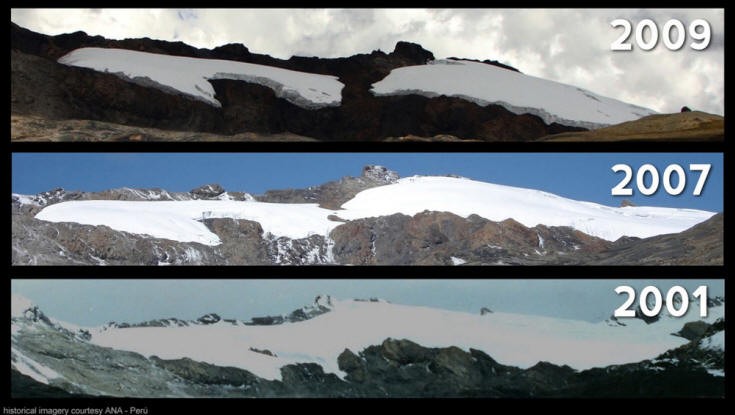
[MELTING GLACIER SOUND]
CURWOOD: Melting ice isn't only a problem up in the Arctic. Glaciers are quickly melting in mountains in the tropics. And a case in point is the one-time skiing tourist destination in the Andes in Peru called the Pastoruri Glacier. Mitra Taj is a correspondent for Reuters, and a former producer and reporter for Living on Earth. We reached her in Lima, Peru, where the government is working on a novel plan to address tourism in the face of the rapid retreat of the glacier, and the prospect of its disappearance within a few years.
TAJ: The pictures that you see in the nearby city of Juarez in hotel rooms and hotel lobbies and restaurants, you see this big glacier, and there’s people all over it skiing, climbing, having a good time...you don’t see that anymore. You mostly see a big block of ice, and a lot of exposed rock around it, so black rock that used to be covered completely in snow and ice.

Pastoruri Glacier in 2010 (Wikimedia Common)
CURWOOD: So how has the melting glacier affected the regions around it? How’s tourism doing?
TAJ: Pastoruri was the big tourist attraction for a long time. It drew a lot of Peruvians from Lima and nearby cities and towns because it’s just a day away, and you can have fun with your kids. So now that it’s no longer drawing people because it doesn’t look the way it used to look, and you’re not allowed to climb on top of it, and stuff like that, the number of visitors has dropped pretty dramatically, from about 100,000 per year to just 30,000 last year.
CURWOOD: So I gather the plan is to figure out another way to get tourists there by making it a climate change tourism destination? What’s going on with that so far?
TAJ: I think they’re targeting tourists that are interested in things like science and climate change, and also people that want to see something that might not be around that much longer, and you’ll hear them talk about what it used to look like. You know, this used to be an international skiing destination, we used to have international ski competitions here; we used to see children running along and building snowmen, and you contrast that with what you see now and the changes that are happening as a result of the glacier melt, and it’s unique I think in terms of travel destinations.
CURWOOD: Now, other than being a tourist destination, I’m sure the glaciers are also an important source of water for local people. How are they being affected by this rapid melting?
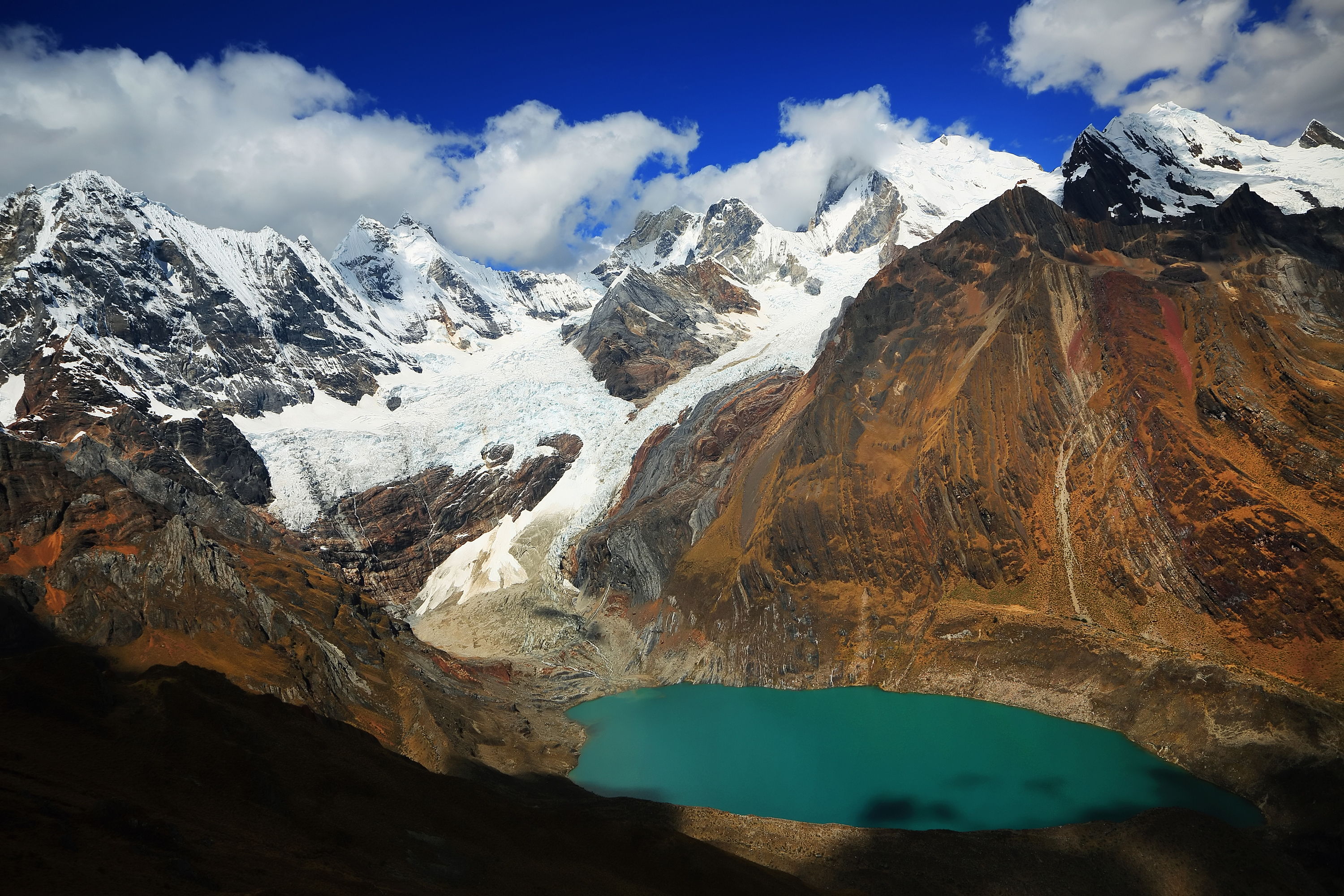
Peru is home to some 700 glaciers. (Bigstockphto.com)
TAJ: That’s an interesting topic. I don’t think there’s been any very serious studies done on it yet but as the water’s melting off it’s taking minerals with it that used to be buried in snow and ice and sort of frozen into place, and that’s more and more of a concern...there’s levels of heavy metals that are unsafe for drinking. The local water company that provides water to the city of Juarez actually had to change the river that it gets its water from because levels of metals were so high that it wasn’t really safe for drinking.
CURWOOD: Pastoruri Glacier isn’t the only one melting in the Andes. This is a regionwide phenomenon, I would imagine.
TAJ: Yes, Pastoruri is in the national park of Huascaran, which has, I think, 700 or something glaciers, and they’re all melting very quickly. In the past few decades, in total, Peruvian glaciers in the Andes have melted to 30 to 50 percent of their previous size. It’s happening really quickly, that tropical glaciers are some of the most sensitive formations to global warming which is why it’s easy to watch them and see what’s actually happening, and that they reflect the global temperature rise really well.
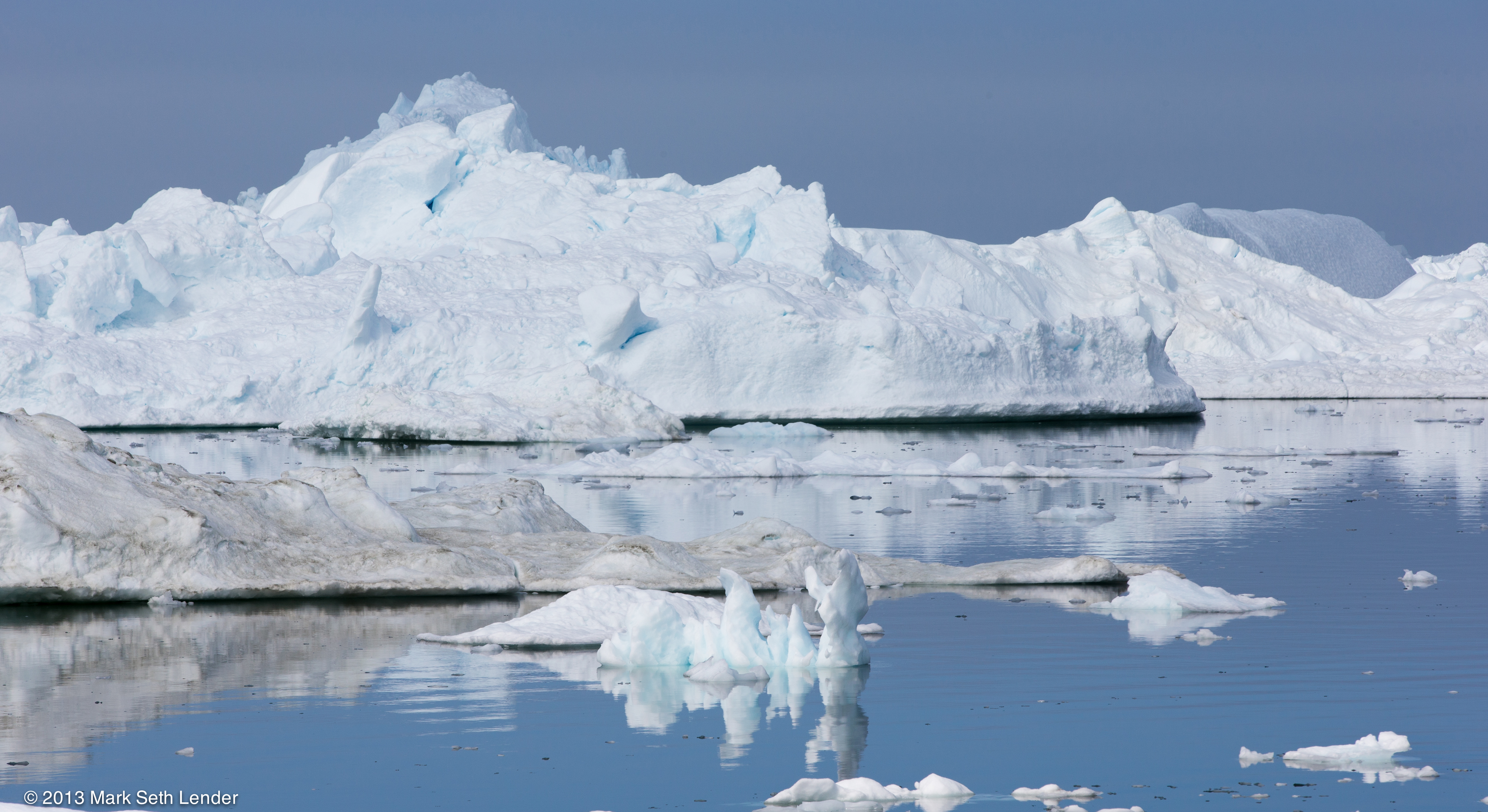
Iceberg off the coast of Greenland (photo: Mark Seth Lender)
CURWOOD: What do you think the average person living in this area thinks about this melting glacier in terms of climate change? Do they make the association?
TAJ: Oh, yes. You can ask anybody that lives in these towns near the glaciers and I think it’s very clear that it’s climate change. They can talk to you what it used to look like, about how it’s much brighter now, the sun shines harder. I don’t think there’s any doubt in their mind that climate change is driving this.
CURWOOD: Mitra Taj is a correspondent for Reuters. Thanks so much for taking the time today, Mitra.
TAJ: Thank you, Steve.
[MUSIC: Paul Butterfield Blues Band w/ Mike Bloomfield “I Got A Mind To Give Up Living” from East –West (Elektra Records 1966)]
ICEBERGS!

Sun scalloping (photo: Mark Seth Lender)
CURWOOD: When glaciers reach the sea, they release icebergs and for many they're both fascinating and dangerous. Writer Mark Seth Lender encountered his first icebergs off Greenland aboard ship with Adventure Canada. He was impressed by their unexpected beauty and scale, and that something special deep inside that few people have ever seen – or rather, heard.
LENDER: In the channeled quiet of dawn, at the first thin edge of Antemeridian, at latitudes dark this time of year, not far from the place they were born, under sky so clear, on a sea like mercury: Icebergs!
Eons of snow crushed by its own weight is their point of conception, in embryo a slow-flowing river of ice: white from above, blue within, hard as the ancient granite shield wearing away beneath. Towards the sea the ice river goes, drawn by an irresistible force. There, at a shore of her own making, Ilulissat Glacier lies down to give them birth, sons and daughters made of ice. Within the narrows of the fjord they abide, then stroll at a casual pace out into Disko Bay. Wind and current carries Ilulissat’s children on, and on; too distant now to hear the water breaking, the crashing, the waves thrashing in the moment they came into the world. Having drifted away, they will never be back.

Iceberg melting (photo: Mark Seth Lender)
By glacier, whole ranges of mountains return to sand and dust. Peaks are worn down into valleys. The valleys scoured by a torrent roaring beneath the ice. The watercourses and the bays are drowned in silt; the land is transformed, unrecognizable. Just so, by sunlight, by salt, mountains of ice waste away. Icebergs too large to measure at human scale are carved and scalloped in the brilliance of the arctic sun and on the waterline weathered by currents and by tides. Edges undercut, the balance of above and below becomes untenable. With no warning, icebergs pitch-pole like great ships in a following sea, or, like ocean liners roll, over on their sides.
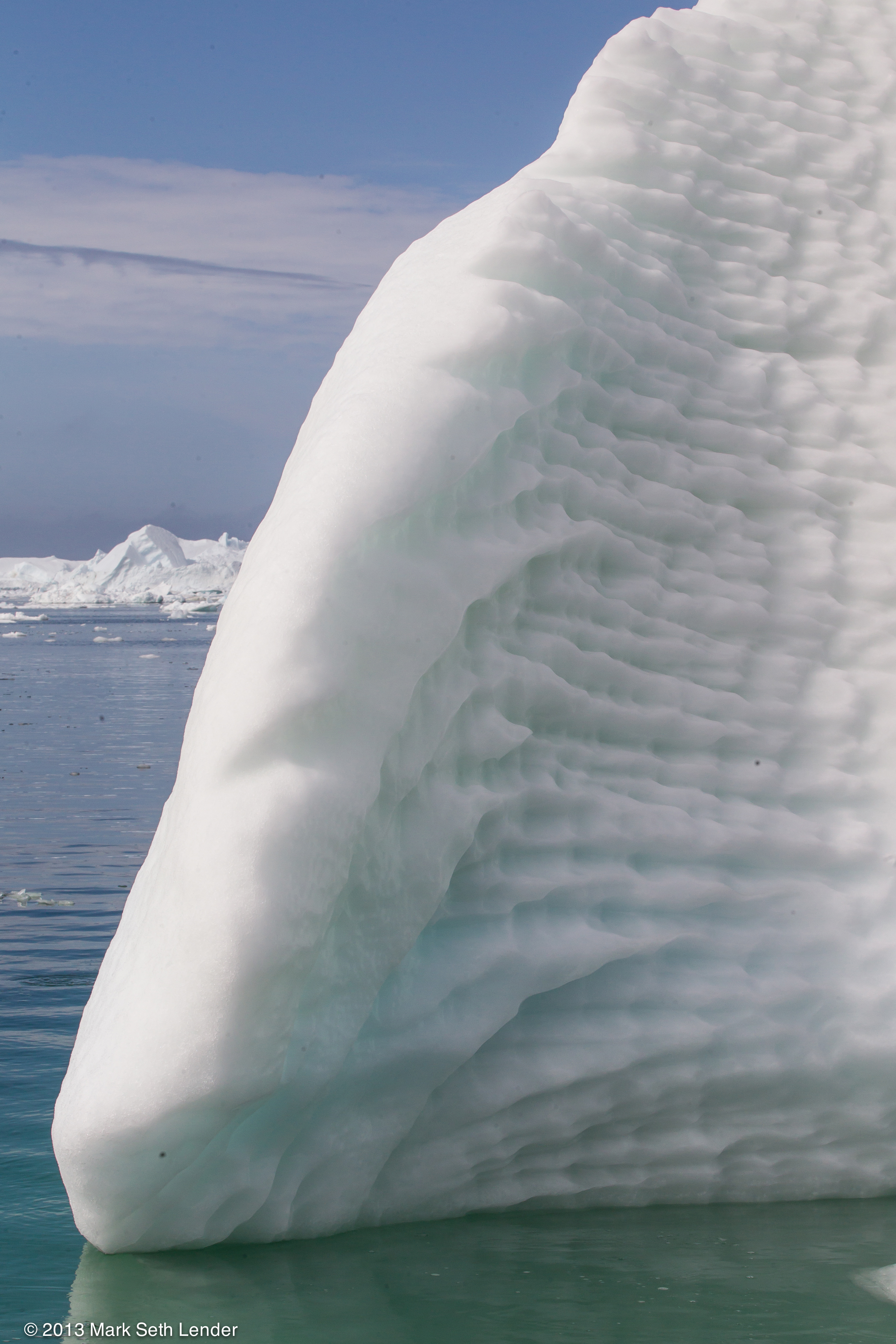
These tracks in the ice are caused by ancient air coming to the surface (photo: Mark Seth Lender)
Tumbling like foundering galleons their final treasure is then revealed. Sequestered within the tiny crystalline flakes of snow there was air, trapped as snow became ice. Now in a sudden underwater rush (like the gush of champagne into the narrow glass) ancient atmosphere blind to all things for ten thousand years sings suddenly escaping. It is the last long gasp of an iceberg returning its breath to the world, a shimmering, bubbling froth, breaking…

Iceberg off the coast of Greenland (photo: Mark Seth Lender)
Along with the breath the remnant of the body and the blood also depart. Ringlets and driplets chime the surface, thermoclines in sinewy patterns spread underneath; the music and the form of Icebergs vanishing.
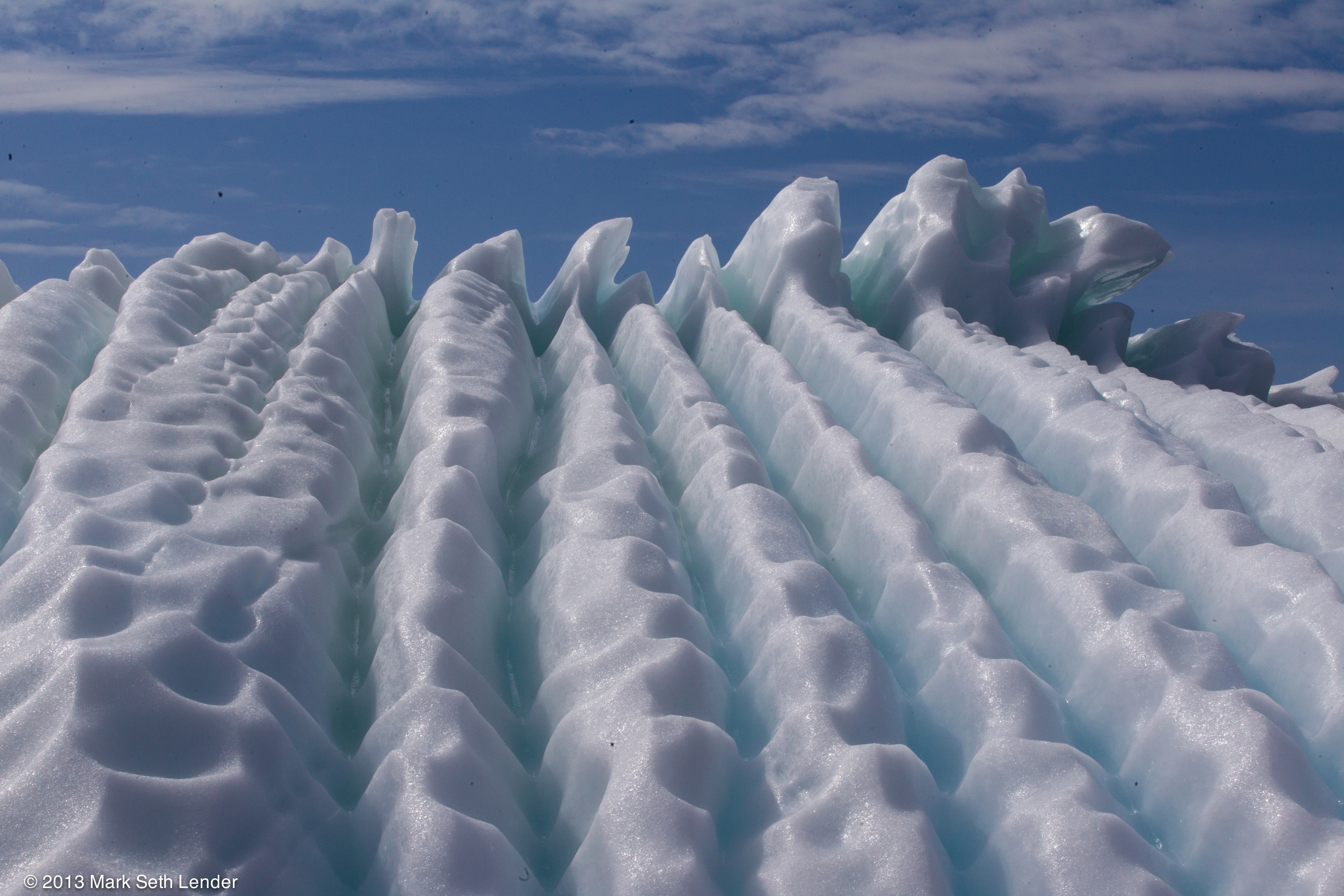
The dimples on this ice are caused by the sun, and the deep ravines are the result of ancient air escaping (photo: Mark Seth Lender)
Ocean was the source and to the source they have returned.

Sun scalloping (photo: Mark Seth Lender)
CURWOOD: To check out some photographs Mark Seth Lender took of icebergs from just a few meters away, drift on over to our website, LOE.org.
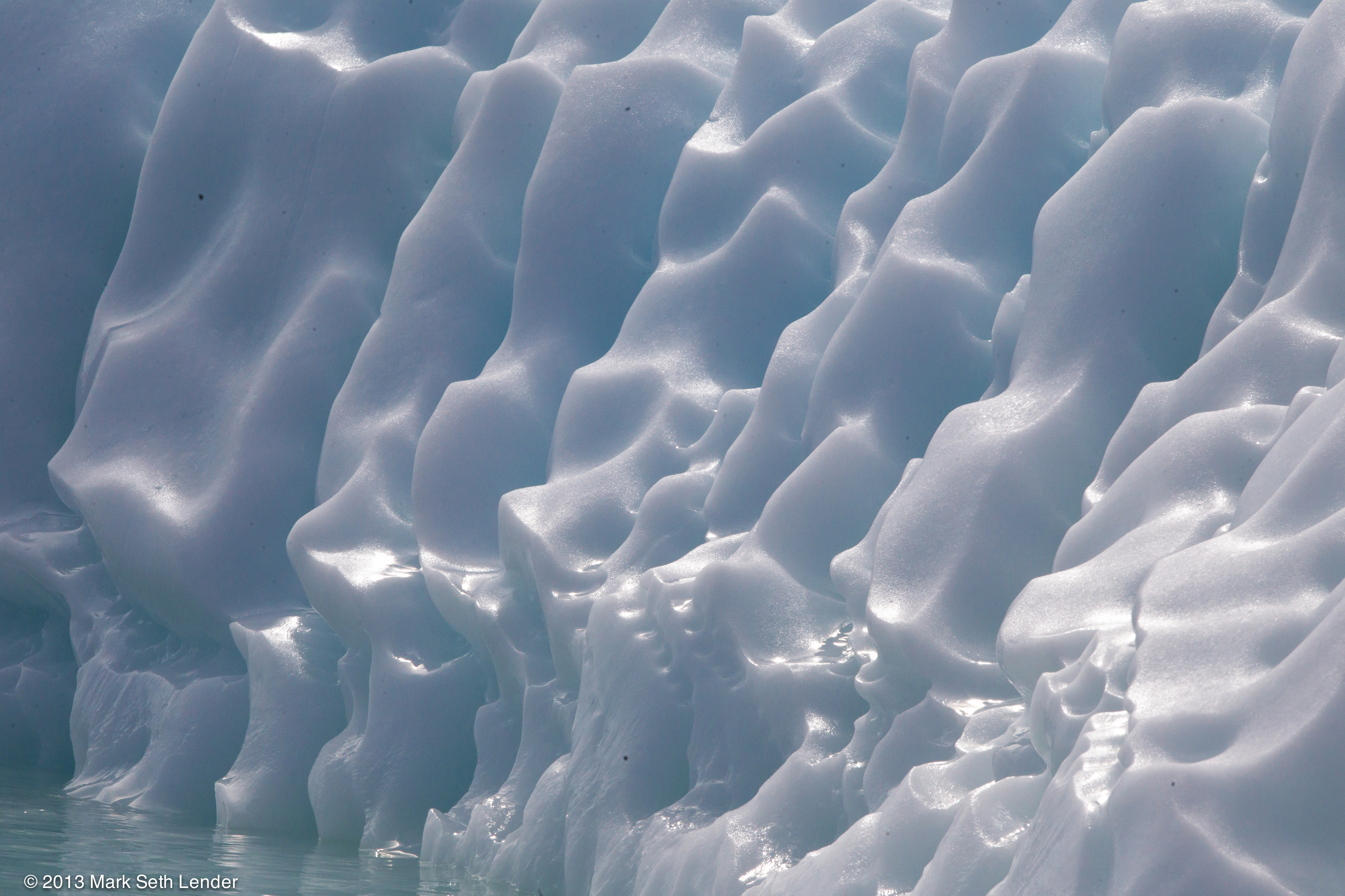
More sun scalloping (photo: Mark Seth Lender)
Related link:
Visit Mark Seth Lender’s website
[MUSIC: Miles Davis “In A Silent Way (Rehearsal)” from The Complete Silent Way Sessions (Sony Music 2001)]
CURWOOD: Living on Earth is produced by the World Media Foundation. Naomi Arenberg, Bobby Bascomb, Emmett Fitzgerald, Andrew Keys, Helen Palmer, Kathryn Rodway, Adelaide Chen, James Curwood, Jennifer Marquis and Gabriela Romanow all help to make our show.
Jeff Turton is our technical director. Alison Lirish Dean composed our themes. You can find us anytime at LOE.org, and like us on our Facebook page - it’s PRI’s Living on Earth. And we tweet from @LivingOnEarth. I'm Steve Curwood. Thanks for listening.
ANNOUNCER 1: Funding for Living on Earth comes from the Grantham Foundation for the protection of the environment, supporting strategic communications and collaboration in solving the world’s most pressing environmental problems. The Kendeda Fund, furthering the values that contribute to a healthy planet, and Gilman Ordway for coverage of conservation and environmental change. Living on Earth is also supported by a friend of The Nation, where you can read such environmental writers as Wen Stevenson, Bill McKibben, Mark Hertsgaard, and others at TheNation.com. This is PRI, Public Radio International.
ANNOUNCER 2: PRI, Public Radio International.
Living on Earth wants to hear from you!
Living on Earth
62 Calef Highway, Suite 212
Lee, NH 03861
Telephone: 617-287-4121
E-mail: comments@loe.org
Newsletter [Click here]
Donate to Living on Earth!
Living on Earth is an independent media program and relies entirely on contributions from listeners and institutions supporting public service. Please donate now to preserve an independent environmental voice.
NewsletterLiving on Earth offers a weekly delivery of the show's rundown to your mailbox. Sign up for our newsletter today!
 Sailors For The Sea: Be the change you want to sea.
Sailors For The Sea: Be the change you want to sea.
 The Grantham Foundation for the Protection of the Environment: Committed to protecting and improving the health of the global environment.
The Grantham Foundation for the Protection of the Environment: Committed to protecting and improving the health of the global environment.
 Contribute to Living on Earth and receive, as our gift to you, an archival print of one of Mark Seth Lender's extraordinary wildlife photographs. Follow the link to see Mark's current collection of photographs.
Contribute to Living on Earth and receive, as our gift to you, an archival print of one of Mark Seth Lender's extraordinary wildlife photographs. Follow the link to see Mark's current collection of photographs.
 Buy a signed copy of Mark Seth Lender's book Smeagull the Seagull & support Living on Earth
Buy a signed copy of Mark Seth Lender's book Smeagull the Seagull & support Living on Earth

